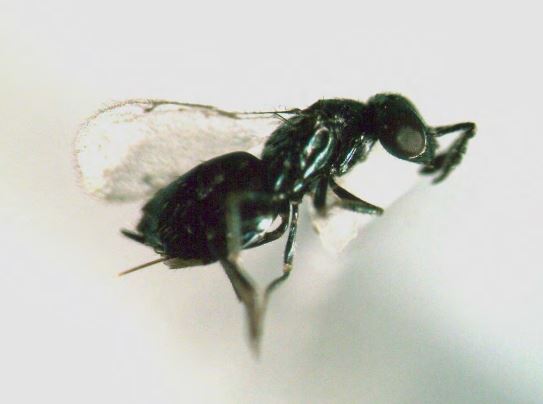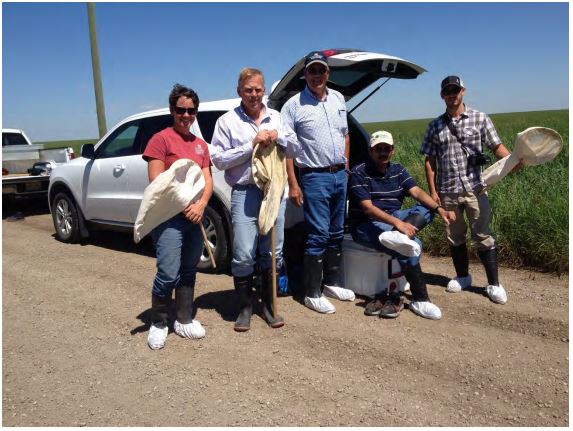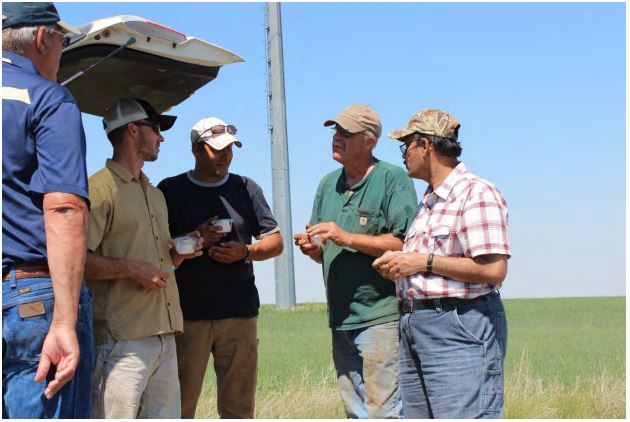Initiation of classical biocontrol in Montana for orange blossom wheat midge Sitodiplosis mosellana (Diptera: Cecidomyiidae) using Macroglenes penetrans (Hymenoptera: Pteromalidae)
Principle Investigator: Gadi V.P. Reddy
Cooperators: Brian Thompson, Dan Picard, Sindhu Krishnankutty, John Miller, Julie Prewitt, Western Triangle Ag Research Center, 9546 Old Shelby Rd., P. O. Box 656, Conrad, MT 59425
Bob Stougaard, Brooke Bohannon, Northwestern Agricultural Research Center, 4570 MT Hwy 35, Kalispell, MT 59901
Background:
The orange blossom wheat midge, Sitodiplosis mosellana, is one of the most significant pests of wheat to enter Montana in the last ten years. This pest damages wheat seeds during larval development and reduces crop value and yield. The population growth potential for this pest is very large. In a multi-pronged study aimed at monitoring pest populations and deriving solutions to reduce damage from this pest, the researchers at WTARC obtained permits to collect the natural enemy of OBWM (Macroglenes penetrans; Figure 1) from locations in Canada and release them into the state of Montana. This parasitoid lays its eggs inside the eggs of OBWM, where they develop and ultimately kill the midge larvae. The population growth potential of this natural enemy matches that of the midge and promises to be a powerful tool in mitigating midge damage in Montana wheat.
To begin with the biological control work, the federal permit (#P526P-14-01543) was obtained in April, 2014 to import M. penetrans from Canada to Montana.
Methods:
-
-
Travel to locations in Canada where researchers have found populations of M. penetrans
-
Collect M. penetrans
-
Return to Montana
-
Release M. penetrans
-
Monitor M. penetrans and OBWM populations at release sites.
-
Results:
M. penetrans was collected from two wheat fields (Claresholm - N 49.61 W113.28) and Fort McLeod – N49.88 W 113.32) near Lethbridge, Canada Figure 2 (purple). Seven hundred individuals were collected in total. These individuals were sorted and identified in collaboration with Drs. Héctor Cárcamo and Scott Meers (Figure 3) at Agriculture and Agri-Food Canada. M. penetrans were transported to Conrad and Creston Montana for release (Figure 2 (lavender)).Each location released approximately 260 live adults. At release sites (Figure 4) and at various other locations in the state (Figure 2 (red)), wheat fields were sampled for the presence of M. penetrans. These samples revealed M. penetrans in low numbers in all of the Flathead valley samples and in the majority of the samples from east of the continental divide.
Discussion:
M. penetrans is present in Montana in certain locations. The introduction to fields east of the continental divide, where midge is just becoming a major pest, have the potential to mitigate the extensive damage this pest is capable of. To study the impact of these biocontrol agents, we plan on continually sampling for adult parasitoids and parasitized larvae. For this purpose, we successfully obtained an equipment grant for a machine that washes midge larvae from the soil. These diapausing larvae can then be tested for the presence of parasitoids. The researchers at WTARC are also pursuing genetic analysis techniques for streamlining the identification of M. penetrans. This study is ongoing.
Acknowledgments:
This work was supported by Montana Wheat and Barley Committee and United States Department of Agriculture- Cooperative Regional Project W3185 Biological Control in Pest Management Systems of Plants. We greatly appreciated Mr. Scott Meers and Dr. Héctor A. Cárcamo (Agriculture and Agri-Food Canada) for their help during the exploratory trip.
Figure 1: Parasitic wasp (Macroglenes penetrans)
Figure 2: M. penetrans collection, survey and release sites in 2014.
Figure 3: Biological control team; L to R: Brooke Bohannon, Scott Meers, Dan Picard, Dr. Gadi V.P. Reddy, Dr. Brian Thompson in the Grower’s field near Claresholm, Alberta (Canada)
Figure 4: Biological control team explaining to the growers about the establishment of parasitoid wasp and its sensitivity of insecticides.




